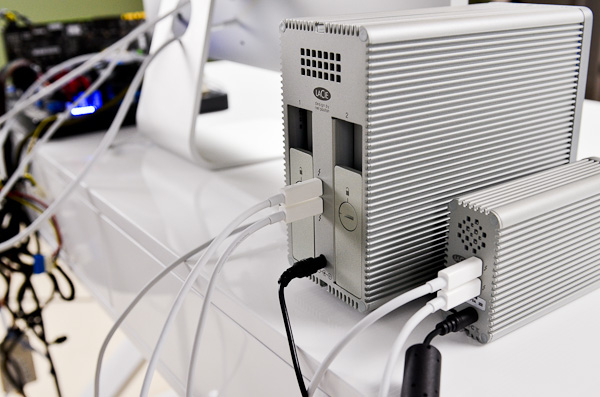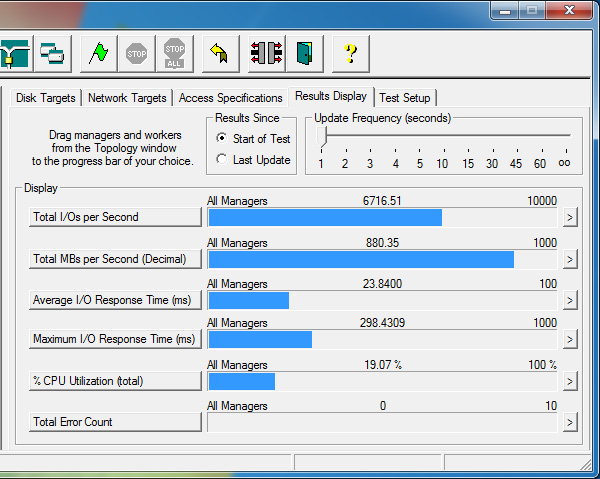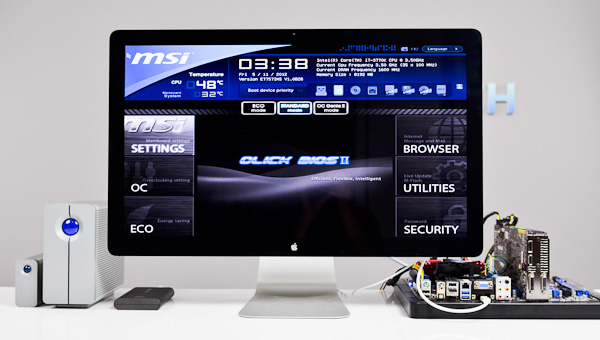A First Look at Thunderbolt on Windows with MSI's Z77A-GD80
by Anand Lal Shimpi on May 11, 2012 1:32 PM EST- Posted in
- Motherboards
- CPUs
- Intel
- MSI
- Thunderbolt
The Storage Devices & Performance
Other than Apple's Thunderbolt Display, every other TB device we've tested has been some sort of storage device. In my lab I've got Promise's Pegasus R6, LaCie's 2big and Little Big Disk (SSD), Seagate's GoFlex Thunderbolt adapter and Elgato's Thunderbolt SSD. With the exception of the Pegasus R6, which currently lacks Windows drivers, all of the storage devices I tested worked with MSI's Z77A-GD80 under Windows. Although there are workarounds for getting the Pegasus up and running under Windows, I encountered a number of hangs and general system unhappiness whenever I tried them on this platform. I suspect this has something to do with why Promise has yet to officially release Windows drivers for the Pegasus.
The rest of the storage devices, as you would expect, just worked. I didn't need to install any drivers as all of their internal controllers had native support under Windows 7. Again, I couldn't hot plug any of these devices once Windows was running - all of them had to be present at boot.
Just as I've seen under OS X, with complex Thunderbolt chains you'll sometimes have a device that hangs in the chain and prevents some or all TB devices from working. I did encounter this behavior more frequently under Windows than I did under OS X. Keep in mind that every single Thunderbolt device on the market today was pretty much developed and tested against Macs, it's going to be a little while before we get perfect behavior under Windows. We don't even have perfect behavior under OS X yet either. My hope is that as more platforms ship with Thunderbolt support, and as we get more Thunderbolt devices, compatibility and behavior validation will both improve. I've also heard that the early Thunderbolt controllers were more finicky than Cactus Ridge, so it's possible that newer TB devices that come out this year will just inherently be better behaved. This is purely hearsay however, I don't have any hard evidence to back it up.
Update: Intel tells us that an updated Pegasus driver is in the works that will address the issues we've seen. Other finicky behavior is also expected to be addressed through the Thunderbolt on Windows certification process.
Since I couldn't get the Pegasus working, I had to resort to combining a bunch of my other Thunderbolt storage devices to measure performance. I created a chain combining LaCie's 2big, the SSD Little Big Disk and Elgato's Thunderbolt SSD along with Apple's Thunderbolt Display. I ran a 128KB sequential read test at a queue depth of 32 across all of the drives, while pushing the Thunderbolt Display at its native 2560 x 1440 resolution:
The best I ever got under OS X was 8Gbps using four SandForce SSDs in the Promise Pegasus. At 7Gbps using a far less elegant setup, this isn't bad at all. Keep in mind that while we're reading at 7Gbps, the GD80 was also using around 7Gbps of bandwidth to drive the Thunderbolt Display at 2560 x 1440. Total available bandwidth for a single-port Thunderbolt device is 20Gbps bi-directional (40Gbps total), so there's still additional headroom available.
Moving Forward
MSI's Z77A-GD80 finally brings Thunderbolt to Windows desktops. With a few exceptions, the experience is quite similar to OS X. The major differences are that some devices clearly need more compatibility testing with these new platforms, and that you can't hot plug Thunderbolt devices under Windows. The former is solvable given additional time, while the latter can be more annoying in the long run if a workaround isn't found. For a single, high-speed storage device under Windows, USB 3.0 is going to be the simplest route. It's only when you want to start pushing even more bandwidth and/or add a display into the mix that Thunderbolt becomes your only solution.
Thunderbolt's functionality otherwise looks very similar under Windows as it does under OS X. The interface doesn't require any specific drivers and in the best conditions it just works. Thunderbolt's behavior remains quite finicky however, even more so under Windows. You'll want to wait for either the next generation of Thunderbolt devices or for the current device vendors to get some more time validating their Thunderbolt products on Windows platforms. Given that the first Thunderbolt equipped PC motherboards haven't even shipped yet, you've got some time.
Update: Intel has informed us that we will see updated drivers for Windows certified Thunderbolt devices that will enable hot plugging under Windows. Intel further informed us that MSI's board has not yet made it through the certification process and a lot of these teething issues will hopefully be addressed by then.
For much of the past year I've been calling for cheaper Thunderbolt storage devices, but with the arrival of Thunderbolt on Windows I'll modify my plea: we need more Thunderbolt display devices as well. As the desktop PC evolves, it would be nice to have only a single cable running from your PC to a Thunderbolt equipped display that acts as the IO hub for all of your peripherals. I'm thinking of something like Apple's Thunderbolt Display, but even heavier on the expansion side and with OS-independent display controls.













98 Comments
View All Comments
zanon - Friday, May 11, 2012 - link
Back during your CES 2012 coverage in January you reported on one of the initial planned external expansion boxes, the MSI GUS II. Things like that (I know there are a few others now) seem to be where the story gets truly interesting for mobile users IMO. Even though the bandwidth available is only equivalent to a few lanes, testing like HardOCP's 480 x16 vs x4 article indicates that at single screen resolutions (ie., no more then 2560x1600) graphics cards can perform shockingly well even with severely restricted bandwidth. So more then merely having a hub there's the potential of being able to plug an ultrabook into a hub and have a mid-range full GPU ready to go, along with a screen and other ports. If it all goes smoothly it could really expand the desirability of ultrabooks even farther, making them more and more no-compromise, although it'll probably take the next-gen 40/100 Gbps TB standard to push it farther or handle GPGPU applications. Still exciting stuff.Guspaz - Friday, May 11, 2012 - link
Sadly, the MSI GUS II is not that useful due to only supporting bus power (75W, no external power connectors supported). The fastest (nVidia) card it can support is the GT 640, which isn't that much faster than the integrated graphics it would be intended to replace. Anything faster can't be bus-powered.It would give you a small graphics upgrade over the Ivy Bridge integrated graphics, but not a big enough one to warrant all the cost and effort... and a notebook with discrete graphics could easily outperform it.
If they add support for externally powered GPUs (anything that draws over 75W), then it could be something special.
zanon - Friday, May 11, 2012 - link
That's extremely trivial though, I was only using it as an Anandtech featured example of one initial expansion, not as the ideal solution itself. Not exactly a big deal to stick a tiny external power source in there, in fact it's odd MSI didn't do it in the first place (or who knows, maybe it'll get revised before release), but as the chips themselves become cheaper and get plenty of supply it seems likely other solutions will appear. It feels like one of the real possible killer apps for the interface after all, something that can't be easily replicated through other means.
DerPuppy - Friday, May 11, 2012 - link
they are (villagetronic+others in the egpu community) working on a thunderbolt system..supposedly development support is limited to large partners though because the thunderbolt team at intel is overworked? someday it'll come out, external gpu solutions on >x1 PCIe2.0 connections, that is. the power issue is somewhat of a nonissue if you don't mind bringing around any sort of 12v psu, be it normal atx, sfx, or w/e and just hooking it upRoland00Address - Friday, May 11, 2012 - link
The product tag says the device can support up to 150w cards. See product tag picture here.http://www.eteknix.com/wp-content/uploads/2012/01/...
I also have heard it has been reported there is no 6 pin power thus the device can only do 75w.
If the device can do 150w you can put a 7850 in there, or possibly a gtx 660 (the gtx660 is a personal guess since the gtx 670 tdp was 170w and to do the gpu boost on the gtx 670 the tdp has to be 141w.)
yyrkoon - Saturday, May 12, 2012 - link
Thing is though, even more important than power. Is the technology bandwidth.10 Gbps (one-direction ) really is not that much in the way of graphics card bandwidth. As I recall. a 7600GT from a few years back, could chew through about 20Gbyte /s under intensive situations. So 10 Gbit/s is hardly going to put a dent into that. So with that in mind, we're basically stuck with integrated graphics performance again.
That is, at least until the next iteration of the technology. Maybe.
Still, from a modular system approach, I like the idea. However I doubt it would be practical any time soon ( like you pretty much already said ).
DerPuppy - Saturday, May 12, 2012 - link
No idea where you're getting these metrics from? PCIe 3.0 x16 is 16GB/s so there's no way a 7600GT could have used that much bandwidth. maybe you're referring to the internal memory bandwidth?? It has been proven that an x4 2.0 connection is sufficient for about ~80-90% of the performance of an x16 link in many gaming situationsyyrkoon - Sunday, May 13, 2012 - link
Of course it was the memory bandwidth." It has been proven that an x4 2.0 connection is sufficient for about ~80-90% of the performance of an x16 link in many gaming situations"
You would be very lucky to see half that. It is very likely, that you would see 25% or less of that.
People have been working on this problem for years now. Through other means. Partially, they have succeeded, using the MXM laptop graphics connection. At a cost that begs to wonder why they did not just buy a $2000 laptop to begin with.
You can buy an external graphics enclosure, for laptops, right now. If you're willing to spend ~$800 for it. Then, only if you have the right laptop.
So in ending I will say this. You're dreaming. You're dreaming a dream I have had myself. At some point however, you're going to have to come back to reality.
Oh, one last thing. I should point out that Gigabytes, and Gigabits are not universal with one another. 10 Gigabit == 1.25 Gigabyte. That is, 25% more, than a PCIe 1x 1.0 connection can handle. Under ideal circumstances.
How do you like them metrics ?
repoman27 - Sunday, May 13, 2012 - link
Well, connecting a GPU via Thunderbolt doesn't affect the memory bandwidth, so that's not really relevant.Plus your math is way off. A single Thunderbolt controller can provide 10 Gbps of PCIe bandwidth. A PCIe 1.0 x1 connection provides 250 MB/s (i.e. 2 Gbps) which is 1/5 of what you get from Thunderbolt. Or put another way, Thunderbolt can currently provide the equivalent of a PCIe 2.0 x2.5 connection.
DerPuppy is correct. If driver support with PCIe compression for Thunderbolt connected GPU's was available, we could achieve better than 80% of the real-world performance of a PCIe 3.0 x16 connected GPU with an external solution.
Note the x2 (2 GB/s) performance in these charts: http://www.anandtech.com/show/5458/the-radeon-hd-7...
Jaybus - Monday, May 14, 2012 - link
Yes, more bandwidth is needed to support external high end GPUs, not to mention the simultaneous use of multiple external PCIe devices. This is why the initial Intel project was named Light Peak. Intel Labs silicon photonics researchers never intended the interface to use an electronic PHY. I believe the electronic PHY version (Thunderbolt) was due to Apple's collaboration along with Intel hitting snags in the development of an on-chip optical PHY.. Ultimately, there will be an optical PHY, since the ability to scale the electronic PHY is limited.